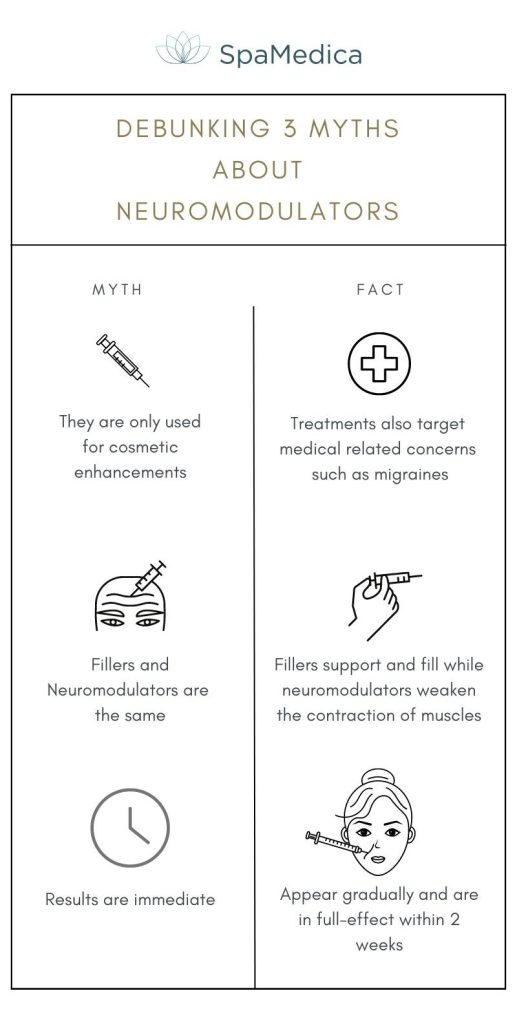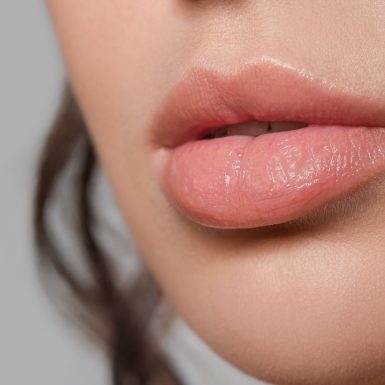Are you curious about the benefits of Botox injections for reducing fine lines and wrinkles? You may be feeling hesitant or unsure about the treatment itself.
To clear up any confusion or uncertainty, the team at SpaMedica has put together this informative post, filled with valuable insights that may help you make educated decisions for your skincare journey.
Discover the ultimate guide to Botox in this must-read blog post. We will debunk the misconceptions, delve into the science behind its effectiveness, and help you determine if it’s the right solution for your unique skin concerns.
So, let’s jump right in!
What is Neuromodulator, a.k.a Botox? How Does it Work?
Neuromodulators, such as Botox, are protein substances that act by blocking neurotransmitter activity in a specific area. Botox, a purified form of botulinum toxin, is the most popular neuromodulator known for its cosmetic applications.
It became common practice to refer to all neuromodulators as Botox, but Botox is just a brand name of one of the most well-known and commonly used brands of neuromodulators for cosmetic purposes. Although several brands are on the market, it has become the catch-all name for wrinkle relaxers.
When injected into targeted muscles, neuromodulators hinder the release of acetylcholine, a neurotransmitter responsible for muscle contraction. By temporarily relaxing and safely paralyzing these muscles, Botox can effectively minimize the appearance of wrinkles and fine lines on the face.
Repeated facial movements over time can transform dynamic wrinkles into static lines, commonly found on the forehead, between the brows (known as elevens), and around the eyes (referred to as crow’s feet). Neuromodulators are utilized to alleviate these muscle movements, preventing the formation of wrinkles.
“The best Botox candidates are those at least 18 years old, physically healthy, not pregnant or nursing, and don’t have a history of neuromuscular diseases such as myasthenia gravis or multiple sclerosis. Other essential characteristics [are those with] healthy skin with moderate elasticity. [They have] realistic goals and expectations for improvement.” — SpaMedica Registered Nurse
What can Neuromodulators Treat?
Neuromodulators work wonders in preventing and reducing dynamic wrinkles, which are wrinkles caused by muscle movements. When it comes to facial injections, your medical aesthetician can administer them in various areas of your face, targeting the most common areas where wrinkles tend to form.
Here is the complete list of areas where injections are commonly administered:
- Facial Wrinkles: Neuromodulators are commonly used to reduce the appearance of wrinkles and fine lines on the face, including:
- Forehead lines or wrinkles
- Frown lines (vertical lines between the eyebrows), also called Glabella or elevens.
- Crow’s feet (lines around the outer corners of the eyes)
- Bunny lines (lines on the nose)
- Brow Lift: Neuromodulators can be used to lift and shape the eyebrows, providing a more youthful and refreshed appearance.
- Gummy Smile: Injections of neuromodulators can help reduce excessive gum exposure when smiling.
- Masseters: Neuromodulator injections can be used to soften the appearance of the jawline by relaxing the muscles responsible for a square or prominent jaw. This can also help with jaw clenching and teeth grinding (bruxism).
- Neck Bands: Neuromodulators may be used to reduce the prominence of vertical neck bands.
- Excessive Sweating (Hyperhidrosis): Neuromodulators can be injected into the underarms, palms, or soles to inhibit sweat gland activity and reduce excessive sweating.
- Migraine Headaches: In some cases, neuromodulators can be used as a preventive treatment for chronic migraines.
- Muscle Spasms and Movement Disorders: Certain neuromodulators are approved for treating muscle spasms and movement disorders, including cervical dystonia (involuntary neck muscle contractions), blepharospasm (eyelid twitching), and certain forms of spasticity.
Extra tip: Can’t tell the difference between dermal fillers and neuromodulators? It’s simple! Neuromodulators treat dynamic lines, while dermal fillers fill in static lines and add volume to contour facial features.

Step-by-Step Guide to Treatment
Consultation: Prior to any injectable treatment, a consultation is conducted to assess your unique anatomy and address your concerns. Our experienced injectors will develop a personalized treatment plan based on your goals while also discussing realistic expectations and considering your budget.
Injecting: Using a small syringe, your injector will carefully administer the neuromodulator into targeted areas. They may ask you to make specific facial expressions, such as raising your eyebrows, to assess the wrinkling on your forehead. The injection is quick and minimally uncomfortable, resembling a brief pinch you’ll hardly notice.
Patience is Key: Unlike dermal fillers, the effects of neuromodulators are not immediately visible. The neurotoxin takes approximately 2 weeks to fully settle and show noticeable results. Therefore, if you observe movement in the treated area after a few days, don’t worry; this is entirely normal.
Schedule Your Follow-up: The effects of the neurotoxin typically last between 3 to 5 months, although longevity can vary depending on the treated area, your body’s metabolic rate, and lifestyle factors. To maintain optimal results, it is recommended to book a follow-up treatment as the neurotoxin gradually breaks down.
Excited to Start Your Injectables Journey at SpaMedica?
As a true premier medical aesthetic clinic in the heart of Toronto, SpaMedica knows it’s important to take a 360° approach to every treatment plan. Because we recognize that skin health encompasses more than the facial treatments we receive- we prioritize a holistic approach.
Do you want to learn more about Botox as wrinkle relaxers?
Book a personalized consultation with one of our treatment designers at SpaMedica. We would be happy to guide you through this important skincare journey!






